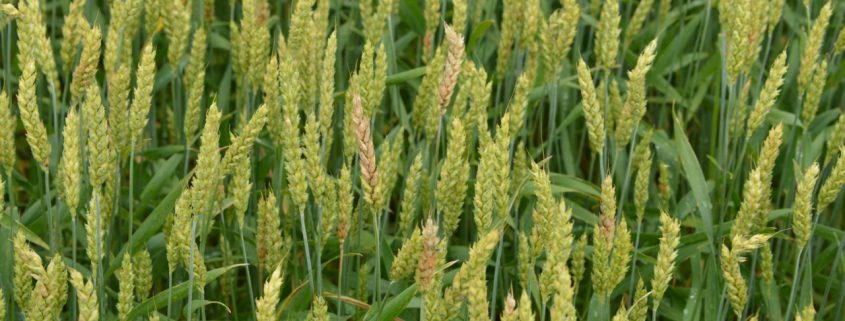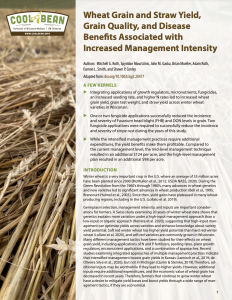Wisconsin Winter Wheat Disease Update – June 1, 2022
Damon L. Smith, Extension Field Crops Pathologist, Department of Plant Pathology, University of Wisconsin-Madison
In Wisconsin, wheat diseases have been nearly non-existent up to this point. Cool weather has generally kept wheat disease at low levels. However, increase frequency of rain events and moderate temperatures over the next 7-10 days will likely increase disease risk, especially Fusarium head blight (FHB or Scab).

Fusarium head blight risk for susceptible winter wheat varieties for June 1, 2022.
We are entering the window for fungicide applications for FHB here in Wisconsin. Currently the Fusarium Head Blight Risk tool is predicting more areas of moderate to high risk in Wisconsin for FHB than it did a week ago (Fig. 1). If highly susceptible wheat varieties were planted in Wisconsin, the current risk is high across most of the state. Rainy conditions in the next seven days will likely push this risk higher. Now is the time to consider a fungicide application to manage FHB in Winter wheat in the state.
In winter wheat in Wisconsin, research has demonstrated that the best time to apply fungicides is between the start of anthesis (first anthers out) to 7 days after the start of anthesis. This same research has demonstrated that waiting to apply fungicides 5 days after the start of anthesis, optimizes deoxynivalenol (DON or vomitoxin) reductions in finished wheat. This is due to the fact that head emergence in Wisconsin can be very uneven. Waiting 5 days after the start of anthesis may help with optimizing application timing to maximize heads flowering and receiving fungicide protection. Fungicide choice is also critical, with Prosaro, Caramba, and Miravis Ace providing the most consistent control of Fusarium head blight and reduction of DON in trials in Wisconsin. Fungicides containing strobilurin fungicides should be avoided after the boot stage of wheat as these products can increase DON levels in finished grain. Fungicide efficacy information from Wisconsin can be found at https://badgercropdoc.com/research-summaries/. National ratings for fungicide efficacy of small grains can be found HERE. Additional thoughts on using fungicide on wheat can be found in this Bumper Crops Video.
We also know that in Wisconsin, that a fungicide application targeted to manage FHB will pay for itself almost every time. You can find published research information on the probability of a return on fungicide investment by clicking HERE. Be sure to focus on comparing the “current” level of treatment to the “mid-level” of treatment in the publication. The only difference between these two treatment plans was the application of fungicide at Feekes 10.5.1 to manage FHB. The “mid-level” plan returned on average more than $120 per acre above the “current” management plan in our trials.
Keep scouting!






